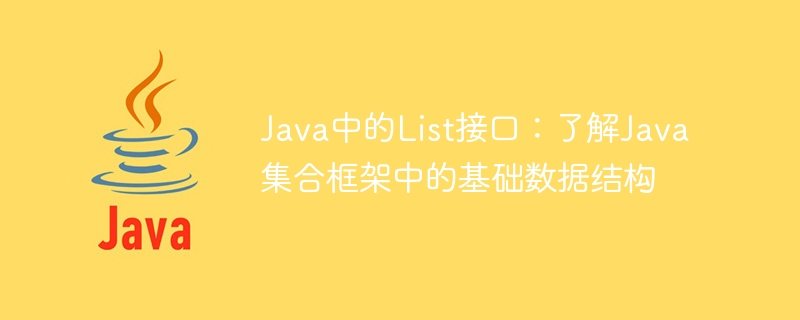

List interface in Java: Understand the basic data structure in the Java collection framework
In Java programming, the collection framework is a frequently used data structure. Among them, the List interface is an important part of the collection framework. It provides an ordered collection that can contain repeated elements. This article will delve into the List interface in Java and introduce its basic features and common implementation classes.
The List interface is a collection in the Java collection framework. It inherits from the Collection interface and represents an ordered set of elements. Elements in the List interface are stored in the order in which they were inserted, and duplicate elements are allowed. In Java, the List interface has many common implementation classes, including ArrayList, LinkedList, and Vector.
First, let us introduce ArrayList. ArrayList is a commonly used implementation class of the List interface. It is based on array implementation and can dynamically grow and shrink. ArrayList allows fast random access to elements, as well as insertion and deletion of elements at the end of the list. Since ArrayList is implemented based on arrays, in most cases it is more suitable for scenarios where you want to find or access elements randomly.
In addition to ArrayList, LinkedList is also another common implementation class of the List interface. LinkedList is implemented based on a doubly linked list, which can efficiently perform insertion and deletion operations at any position in the list. However, due to the extra space required to store references to linked list nodes, LinkedList is generally slightly less performant than ArrayList in finding or randomly accessing elements.
In addition, Vector is an old implementation class of the List interface. It is very similar to ArrayList, but Vector is thread-safe, which means that its various operations are synchronized. However, since synchronization will bring certain performance losses, it is usually more recommended to use ArrayList in non-multi-threaded environments.
In addition to the common implementation classes mentioned above, Java also provides some other List implementation classes, such as Stack and CopyOnWriteArrayList. They all have different characteristics and applicable scenarios, and you can choose the appropriate implementation class based on actual needs.
When using the List interface, some of its common methods are usually used, such as add, remove, get, size, etc. For example, you can use the add method to add elements to the list, the remove method to delete the element at the specified position, the get method to obtain the element at the specified position, and the size method to obtain the size of the list, etc. In addition, the List interface also inherits from the Collection interface, so it also includes methods such as isEmpty, contains, and iterator.
In general, the List interface, as an important part of the Java collection framework, provides programmers with an ordered collection that can easily operate and manage elements. In actual programming, rationally selecting the implementation class of the List interface and optimizing it according to specific business needs can help improve the performance and efficiency of the program.
In this article, we briefly introduce the basic features and common implementation classes of the List interface in Java, including ArrayList, LinkedList, and Vector. At the same time, some commonly used methods of the List interface are also mentioned. I hope this article can help readers gain a deeper understanding of the basic data structures in the Java collection framework and how to flexibly apply the List interface for development in actual projects.
The above is the detailed content of Master the basic data structures used by the List interface in the Java collection framework. For more information, please follow other related articles on the PHP Chinese website!
